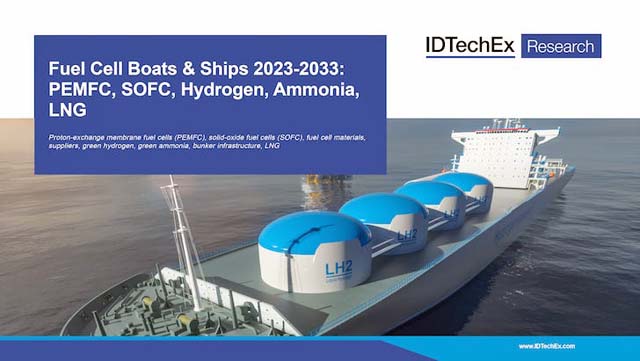With the need for the industry to aim for broader climate goals such as the Paris Agreement and ‘Fit for 55’ in Europe, and the largest vessels tending to contribute the most to maritime emissions, US research consultancy IDTechEx recognises the magnitude of the challenge.
IDTechEx sees green fuels, such as green hydrogen and ammonia, as some of the most promising solutions, with a new IDTechEx report, Fuel Cell Boats & Ships 2023-2033: PEMFC, SOFC, Hydrogen, Ammonia, LNG, predicting that green hydrogen PEMFC (proton exchange membrane fuel cell) and LNG/green ammonia SOFC (solid-oxide fuel cell) markets will grow rapidly at 35% CAGR over a ten-year period.
Currently, LNG is the main alternative fuel in marine markets. The global LNG fleet has been growing for decades, driven by an initial policy aimed at reducing localised emissions such as SOx, NOx, and particulate matter. However, the focus is now shifting towards reducing emissions of greenhouse gases, such as CO2 and methane. IMO policy includes the EEXI and CII, to ensure ships take technical and operational steps to reduce GHG emissions and to measure carbon emissions per amount of cargo carried per mile. Such regulations will be difficult to achieve without fundamental changes to the ways in which vessels are powered.
The new regulations undermine LNG use as a long-term solution because of methane slip, which occurs at every step in LNG’s lifecycle, alongside energy-intensive cooling (–161C) and re-gassing requirements. However, IDTechEx expects the regulations will create opportunities for alternative fuels, including green hydrogen, green ammonia, or e-fuels combined with carbon capture.
The chemical energy held in alternative fuels can be converted into mechanical energy in multiple ways, including combustion; however, fuel cells offer great potential as a highly efficient solution, with a pathway to zero-emissions using green fuels. Currently, there are two main options for fuel cells in the marine environment – PEMFC, using green hydrogen, and SOFC, which are fuel flexible but notably can run on green ammonia, a derivative of green hydrogen.
Today, PEMFCs are the most technologically mature fuel cell technology. This has been driven by high-power density and ambient temperature operation, making them suitable across various transport applications. Technological advancements behind road vehicle PEMFCs are enabling commercialisation in the marine sector.
Leading marine PEMFC suppliers include Nedstack, Powercell, and Ballard, which are vertically integrated pure-play companies. Corvus Energy is another notable contender with plans to release its first FC product over the next few years using fuel cells sourced from Toyota. While none of these companies began supplying fuel cells to the marine sector – Nedstack began with stationary power, PowerCell is a spin-out from Volvo, Ballard supplies heavy-duty road vehicles, and Corvus Energy is the leading maritime battery supplier – all have begun to pivot to the sector as opportunities have been created by regulation and funding.
Innovations from these players are increasing power density and safety, such as the use of novel stainless steel plate materials (increasing volumetric power density by around 40%) alongside double-walled hydrogen pipes, ventilation fans, and hydrogen sensors, allowing the fuel cell to be installed within the ship rather than on the open deck.
Currently, end-use is dominated by a few large systems in inland cargo vessels, workboats, offshore support vessels, tugs, cruise ships, and ferries. Amongst the largest orders are a 3.2MW PEMFC system from PowerCell, a 2MW SOFC system from Alma Clean Power (for the Viking Energy project), and individual 2MW PEMFC orders for the H-Tug and Ulstein OSV to be delivered by Nedstack.
IDTechEx expects that most orders in the mid-term will use PEMFC technology and remain in inland and coastal sectors (due to the volumetric limits of hydrogen). Nevertheless, the IDTechEx report predicts a total of 6MW will have been delivered to vessels by the end of 2022. Since most deliveries are pilot projects for fleet operators, each with fleet sizes of hundreds to thousands of similar vessels, repeat orders are poised to drive rapid market growth.



